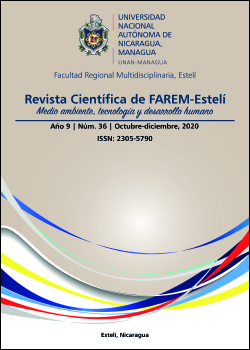Integration of information and communication technologies in innovative didactic strategies to facilitate the teaching - learning processes of functions in the General Mathematics subject in FAREM Estelí
DOI:
https://doi.org/10.5377/farem.v0i36.10609Keywords:
teaching, learning, teaching strategies, mathematical functions, teaching models, Information and Communication Technologies (ICT)Abstract
This research aims to obtain sufficient value judgments for the design of a Didactic Model in which ICT Information and Communication Technologies are included, as an energizing element and enhancer of the learning of the mathematical functions of the program of the General Mathematics subject that is taught in the early years as a basic subject in all UNAN Managua careers. This project aims to provide students, motivated by the use of ICTs, to achieve meaningful learning, which facilitate them to understand the concept of mathematical function, as well as the solution and interpretation of graphs of algebraic, exponential and logarithmic functions, applied to different fields of knowledge. The Didactic Model product of this research, proposes the integration of psychodydychtic elements that are often not taken into account in the facilitation of mathematical contents, and that are a key factor for students to achieve meaningful learning. The elements that the Didactic Model considers, are referred to pay attention to the cognitive processes that are generated in students, the emotional intelligence that the teacher must manage with in the class group and always maintain creativity, innovation and motivation to achieve the competencies that the unit of mathematical functions demands.
Downloads
References
Baelo Álvarez, R., y Cantón Mayo, I. (2011). Las tecnologías de la información y la comunicación en la educación superior. Estudio descriptivo y de revisión. (August 2012), 1013. Recuperado el 11/03/2018 de: http://bit.ly/2QpXbtN.
Cabero Almenara, J. (2004). La transformación de los escenarios educativos como consecuencia de la aplicación de las TICs: estrategias educativas. Formación de la ciudadanía: las TICs y los nuevos problemas, 15. Recuperado el 05/09/2017 de: https://idus.us.es/xmlui/bitstream/handle/11441/17920/file_1.pdf;sequence=1.
Capilla, R. M. (2016). Habilidades cognitivas y aprendizaje significativo de la adición y sustracción de fracciones comunes. Cuadernos de Investigación Educativa, 7(2), 49. https://doi.org/10.18861/cied.2016.7.2.2610.
Del Rosal Sánchez, I., Dávila Acevedo, M. A., Sánchez Herrera, S. y Bermejo García, M. L. (2017). La inteligencia emocional en estudiantes universitarios. Diferencias entre el grado y maestro en educación primaria y los grados en ciencias. International Journal of Developmental and Educational Psychology. Revista INFAD de Psicología, 2(1), 5161. https://doi.org/10.17060/ijodaep.2017.n1.v1.904.
Gargallo López, B., Pérez Pérez, C., Serra Carbonell, B., Sánchez Peris, F. y Ros Ros, I. (2007). Actitudes ante el aprendizaje y rendimiento académico en los estudiantes universitarios. Revista Iberoamericana de Educación, 42(1), 6. Recuperado bde: http://bit.ly/2KnHG1O
González, A. y Martin, M. (2016). Módulo 1 - Conceptos de educación y tecnologías digitales. Sedici, 120. Recuperado de http://sedici.unlp.edu.ar/handle/10915/54373.
Hernández Fernández, A. (2011). La didáctica cómo disciplina pedagógica. En La didáctica de las Ciencias (pp. 114). Recuperado de: http://bit.ly/2q5YLGN
Hernández, R., Fernández, C. y Baptista, M. del P. (2014). Metodología de la investigación. En Journal of Chemical Information and Modeling (Sexta, Vol. 53). Recuperado de: http://bit.ly/2COJ49C.
Ferrando Prieto, M. (2006). Creatividad e inteligencia emocional: un estudio empírico en alumnos con altas habilidades. Recuperado el 19/04/2019 http://bit.ly/37fg499
Jaramillo Naranjo, L. M., y Simbaña Gallardo, V. P. (2014). La metacognición y su aplicación en herramientas virtuales desde la práctica docente. Sophía, 1(16), 299313. https://doi.org/10.17163/soph.n16.2014.13.
Medina Rivilla, A., Domínguez Garrido, M. C., y Sánchez Romero, C. (2011). La Innovación en el aula: referente para el diseño y desarrollo curricular. Perspectiva Educacional, 50(1), 6186. Recuperado de: http://bit.ly/2CMolDj.
Meza Cascante, L., Suárez Valdés-Ayala, Z., y García Delgado, P. (2010). Actitud de maestras y maestros hacia el trabajo cooperativo en el aprendizaje de la matemática. Revista Electrónica Educare, 14(1), 113129. Recuperado de: http://bit.ly/2CMolDj.
Requesens, E., y Díaz, G. M. (2009). Una revisión de los modelos didácticos y su relevancia en la enseñanza de la ecología. Revista Argentina de Humanidades y Ciencias Sociales, 7(1) Recuperado de: https://www.sai.com.ar/metodologia/rahycs/rahycs_v7_n1_03.htm.
Taylor, S. J., y Bogdan, R. (2002). Introducción a los métodos cualitativos de investigación (3a ed.). Barcelona, España: Paidós.
UNAN Managua (2011). Modelo Educativo, Normativa y Metodología para la Planificación Curricular. Recuperado el 19/05/2017 de http://bit.ly/2KqiwzE
Zapata-Ros, M. (2012). Teorías y modelos sobre el aprendizaje en entornos conectados y ubicuos. Bases para un nuevo modelo teórico a partir de una visión crítica del conectivismo. Education in the Knowledge Society, 16(1), 2949. doi: 10.14201/eks201516169102
Downloads
Published
Issue
Section
License
Copyright (c) 2020 Revista Científica de FAREM-Esteli

This work is licensed under a Creative Commons Attribution-NonCommercial-ShareAlike 4.0 International License.

